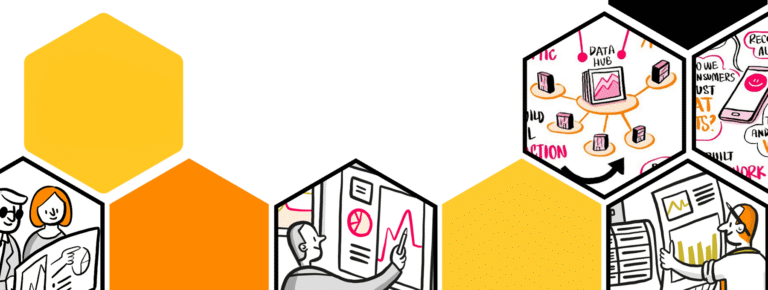As third-party cookies are becoming increasingly out of fashion, businesses are searching for new ways to reach and connect with audiences. Meeting increasing consumer demands for privacy, security, and more control over their data makes this task more challenging.
Regulatory factors such as GDPR, Google’s privacy sandbox, and Apple’s IOS14 update back in 2021 add to the complexity, imposing additional constraints in the marketing and advertising field. Approximately 75% of marketers worldwide still depend on information collected by third-party cookies to shape their campaigns and advertising efforts, fostering both brand awareness and sales.1
After postponing their sunsetting of third-party cookies in Chrome more than once, Google ended up reversing their decision, stating that they will keep them, while introducing “a new experience in Chrome that lets people make an informed choice that applies across their web.”14
Nevertheless it’s clear that going forward, organizations and businesses will need to focus more on gathering first-party data.
To help you navigate both past and future privacy policy changes, we’ll explore strategies to optimize your first-party data approach and discuss how to deliver a personalized, customer-centric experience while ensuring full compliance in a post-cookie era.
TABLE OF CONTENTS
- What is first-party data?
- Tracking Google and Apple privacy changes
- How will these changes impact your business?
- How to prepare for upcoming changes to data privacy laws
- How to get started
- How to deliver personalized experiences without third-party cookies
- How Vaimo can help
What is first-party data?
First-party data is a term that refers to data that you collect directly from your customers. This data is not collected through a third party but via channels you own, such as your website, app, or emails.
First-party data includes, but is not limited to:
- Data in your customer relationship management (CRM) system
- Data from your website, app, and social media accounts
- Data from product-level purchases
- Data from your subscription-based emails
- Data from customer surveys
- Data from customer feedback
- Data from your loyalty program
Third-party data, in contrast, consists of information collected by a party that does not have a direct relationship with the person whose data is being collected. Third-party data is often collected from various websites and platforms and then aggregated by third-party data providers. For example, third-party data is often collected in the following scenarios:
- Mobile apps
- Social media platforms
- Data brokers
- Ecommerce websites
- Online advertising platforms
Now that we’ve clarified that, let’s look at changes affecting what data will be available to brands in the future.
Tracking Google and Apple privacy changes
From a marketing or even tech perspective, it can be frustrating to have to leave cookies behind because we know that it’s not only about tracking and surveillance but about curating engaging digital experiences. However, from a consumer perspective, the perceived cost of surveillance clearly outweighs the rewards. It’s interesting to note that only 13% of consumers state they will miss cookies and believe they create a better online experience.2
Understandably, consumers are concerned about data privacy. Privacy regulations such as the EU’s GDPR and California’s CCPA have been implemented to increase online privacy and provide transparency to the consumer.3,4 The big players have received great pressure to improve data protection.
In recent years, both Mozilla Firefox and Apple Safari have added new features to their web browsers to stop cross-site tracking.
Apple began its privacy efforts in 2015 with Safari, allowing iOS users to install content blockers that could block certain elements on web pages, like ads.5
In 2017, Apple introduced Intelligent Tracking Prevention (ITP), a privacy feature that blocks third-party cookies by default and limits the lifespan of certain first-party cookies and other data storage methods.6
In 2019, ITP 2.2 and 2.3 were released, which meant cookies were automatically deleted after 24 hours. This has, of course, restricted companies’ ability to track consumers even more.
In 2019, Firefox took a step toward safeguarding user privacy by introducing Enhanced Tracking Protection (ETP), which began blocking third-party cookies by default.7
In January 2020, Google Chrome announced it would also stop supporting third-party cookies in the next few years.8
In April 2021, with the launch of IOS 14, mobile application providers are now required to ask their users for approval to gather tracking data.9 In other words, iPhone users can now opt-in to keep seeing targeted ads in their mobile apps. Explicit consent is now needed, whereas previously, users were tracked by default unless they opted out.
In 2022, Google announced significant privacy updates that would limit the ability of advertisers to track Android users’ activity across apps, especially when it’s done covertly.10
For several years, Google’s plan was to end support for third-party cookies in Chrome.11 In July 2024 they reversed their decision to deprecate the third-party cookie, in favor of giving the Chrome users the possibility to make a more informed privacy choice.14
The big “take-away” here is that consumers are more privacy-conscious than ever before. As a result, major platforms are forced to react to the market expectation of privacy. The solution is to commit to forging honest, meaningful relationships with consumers and adopting a fully-fledged privacy-first strategy.
How will these changes impact your business?
The area that is the most impacted by these changes is targeted advertizing. As the possibility of tracking many online actions is reduced, how businesses handle ad attribution will need to change. The main strategies that will be impacted are:
- Behavioral targeting
- Retargeting campaigns
- Lookalike audience targeting
- Programmatic ad buying
The way forward will most likely be to get better at using data from your sources, such as your website and emails. Brands must also embrace privacy-friendly ways to track and measure online behavior. You can do this by leveraging your data and tracking interactions with your touchpoints.
Below are five tips to help you prepare for these changes.
How to prepare for upcoming changes to data privacy laws
1. Use first-party data
The first step toward an efficient first-party data strategy is to get your data house in order. Many brands skip this step and head straight for tactics, which is a mistake. First, ensure you have access to solid/clean data, preferably through a customer data platform. There are still many options to enhance that customer data with additional demographics and behavioral data.
A centralized data lake creates universal user IDs to enrich customer journeys through touchpoints, allowing for smarter retargeting and marketing. A data lake allows you to store your data in any format and eliminates the need for data silos, building a strong foundation for machine learning and AI-powered analytics.
When you have your data in order, you can start focusing on optimizing every part of your funnel. The best idea is usually to optimize from the bottom of the funnel and then move upward. Get crystal clear on how you’re moving users through the funnel and getting existing users to stay.
Once you know this, you can focus on getting new prospects at the top of your funnel, which brings us to the following question: how do you get people to the top of your funnel? Doing so requires new ways of increasing traffic and conversions on your site.
2. Improve the quality of your content
Every brand wants to increase site traffic; that makes perfect sense. However, focusing too much on acquiring new traffic can sometimes make marketing teams lose sight of the traffic already going to the site. Additional traffic will not help if there isn’t already a great website that provides value to users.
By focusing on technical SEO (Search Engine Optimization), a brand can optimize a website that needs to conform to best practices for search visibility. There is tremendous value in having a well-optimized site from a technical standpoint; however, technical SEO can only help a site improve the visibility it ALREADY has.
Therefore, on-site SEO will become even more critical as ads become less potent. And the overall quality of the content you produce will determine how many visitors you attract and how likely they will return. A revised commerce content strategy may also be in order.
It will also be essential to design better processes for data collection at key touchpoints to get a complete view of the buying journey. Today, many companies inadvertently let large amounts of data pass them by, and then they have to guess to fill in the blanks. The amount of data available to large brands daily can be overwhelming. However, revising data capture and reporting processes may yield significant insights.
3. Build trust with customers
Unlike third-party data, first-party data is unique to your business. It’s data that you own and can collect with direct consent from your customers and visitors through various interactions on apps and websites and in response to marketing initiatives, like email and loyalty programs. When used well, first-party data will help you build direct relationships with your customers in a way that creates value for them—while boosting your business as well.
And remember, collecting first-party data requires trust. You need to take a transparent, step-by-step approach and gradually build relationships where your web visitors and customers are willing to share information with you. Progressive profiling is your best bet at building up customer profiles that will enable you to personalize your marketing.
4. Invest in personalization
Brands know personalization is important. Still, their strategies for learning about consumers haven’t always been the most informative. Consumers’ preferences are ever-changing; for instance, 90% of consumers in the U.S. who have switched brands or retailers say they will continue to do so in the future.12
This means marketers need to be able to capture live audience insights and translate them into messaging that resonates. Given their short shelf life, cookies are not the best tool to help marketers understand and anticipate consumers’ preferences.
Considering that 90% of U.S. consumers have a positive attitude toward marketing personalization, marketers need to understand those who interact with their brand as well as how these insights can change over time.13 Marketers should establish privacy-compliant first-party data collection to deliver the authentic communications consumers want from the brands they engage with.
5. Look at new strategies
Sometimes, making significant strategic decisions like moving your product into a mobile app will be what it takes. Doing so can allow you to collect solid first-party data. The key is to be aware of this evolution and move toward an ecosystem that does not rely on cookies and third-party data.
Marketing technology like analytics systems with attribution capabilities can provide brands with more valuable insights than what will be lost from cookies’ disappearance. By gaining a clearer understanding of how consumers react to messaging, marketers can pinpoint which aspects of their strategies are impacting consumers positively and determine which ones may require adjustments.
For example, marketers can see whether a consumer clicks through an in-app advertisement or minimizes it, which clues them into how engaging the ad is and if it should be revised or replaced.
How to get started
With all of the information, where do you start? Here are five tips to help you think about your first-party data strategy.
- Define your goals: With a first-party data strategy, you’ll need to know what it is you want to do for your customers. Are you trying to understand behaviors better? Or are you looking to prompt real-time personalization? Or add an omnichannel experience? Any part of your strategy can be improved by leveraging first-party data.
- Define your target audience: To define your target audience, you’ll need the correct first-party data from channels like web, mobile, CRM, apps, and your product itself. For example, your visitors can be segmented by online behavior, affinity, and common demographics to develop a personalized marketing strategy.
- Define your method: After you’ve sourced the correct first-party data, you’ll need to understand which specific data points you need to support your use case. For example, transactional data is meaningless until it is put into context, like time since the last purchase, lifetime value, product usage, etc.
- Define your usage: Segmentation evolves with your access to data. How do you define a VIP or fan? Creating an omnichannel experience tailored to your audience starts with deciding which insights to use in which channels.
- Define success: What data points will you use to measure success? This is an ongoing process. Your insights will help you get the most out of customer experience and analysis tools. To effectively measure your success, you will need to use reporting tools and platforms, allocate resources, check in from time to time, and request feedback.
How to deliver personalized experiences without third-party cookies
You can still deliver tailored experiences for your customers without third-party cookies while ensuring full compliance with data privacy laws.
Here are eleven tips we recommend to our clients.
- First-party data: Encourage your customers to share their information through transparent and user-friendly methods. Offer incentives, such as tailored recommendations or exclusive/early access, in exchange for their data.
- Customer accounts: Use customer accounts to collect first-party data. You can use the data, such as preferences, order history, and their wish list, to tailor the shopping experience.
- Consent management platforms (CMPs): Use CMPs to manage user consent for data collection and ensure compliance with privacy regulations. Be transparent about why you’re collecting data and obtain consent for personalized experiences.
- Tech to the rescue: Tech is advancing faster every day; take advantage of it! Machine learning and AI (artificial intelligence) are great tools to analyze user behavior without relying on third-party cookies. Predictive analytics can help you understand and anticipate customer behavior and preferences.
- CRM systems: Customer relationship management systems, or CRM systems, can help you centralize and manage customer data effectively. Use your CRM data to conduct segmentation and targeting for tailored marketing campaigns.
- Contextual targeting: Use a shopper’s current browsing session and behavior on your site for real-time personalization. By understanding the context of a shopper’s visit, you can tailor your content accordingly.
- Be transparent: Communicate your data usage policies and privacy measures with your customers, and offer options for users to choose their privacy settings and preferences.
- Get your customers on board: Educate your customers about the benefits of sharing data for personalized services, and how it enhances their overall shopping experience.
- Work with trusted partners: Ensure that the technology partners and advertising platforms you work with also prioritize user privacy and comply with data regulations. Make sure that your third-party partners are transparent about their data privacy and compliance efforts. Remember, it’s your reputation on the line–even with third-party partners.
- Be data-driven: Routinely analyze the performance of customized experiences without relying on third-party cookies. Optimize strategies according to customer feedback, preferences, and changing market dynamics.
- Use a CDP: Customer data platforms, or CDPs, gather, unify, and manage customer data from various sources in a centralized hub. A CDP can help you create targeted marketing campaigns, and tailored experiences, and improve overall customer engagement.
How Vaimo can help
With over 16 years of experience working with ecommerce retailers and brands, we recognize the value of customer data. We work closely with you to understand your business goals and needs and determine whether a CDP is the right choice for your business.
We’ll help you choose the right CDP and make sure it smoothly integrates with your existing tech. We work with Adobe Real-Time CDP and Twilio to bring our clients the best selection of platforms. And finally, check out our in-depth CDP ebook that we published with help from our Vaimo data masters below.
Sources
1 – Third-party cookie deprecation – Statista.com
2 – How will marketers curb their third-party cookie cravings? – insiderintelligence.com
3 – GDPR – gdpr-info.eu
4 – California Consumer Privacy Act – oag.ca.gov
5 – Safari Content Blockers Under the Hood – infoq.com
6 – Apple’s Intelligent Tracking Prevention on Safari – getcake.com
7 – Today’s Firefox Blocks Third-Party Tracking Cookies and Cryptomining by Default – mozilla.org
8 – Building a more private web: A path towards making third party cookies obsolete – chromium.org
9 – How Apple’s iOS 14 release may affect your ads – agentur-loop.com
10 – Google to restrict apps from tracking you on Android devices – cbsnews.com
11 – Google will disable third-party cookies for 1% of Chrome users in Q1 2024 – techcrunch.com
12 – How US consumers are feeling, shopping, and spending—and what it means for companies – mckinsey.com
13 – Attitudes towards marketing content personalization – statista.com
14 – A new path for Privacy Sandbox on the web – privacysandbox.com








